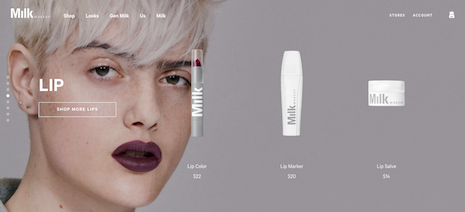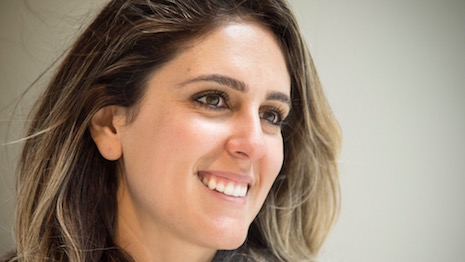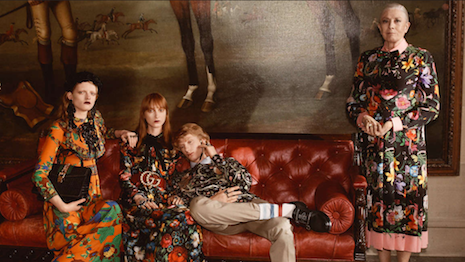By Jasmine Bina
Over the years I have realized that my consumption of luxury, and even the very definition of it, has drastically changed. As someone who both studies millennials and counts among them, I have always felt this shift happening, but I really noticed a striking difference during this year’s fashion weeks.
I watched most of my shows via select model or celebrity snaps, not even the Snapchat handles of the designers themselves. Even then, my favorite highlight was watching Kylie and Tyga hang out with Luka Sabbat in a hotel room after a long day of front row runway snaps. I wanted to virtually spend time with certain people that were there.
Sure, our consumption behavior has changed and modern celebrity is melting into design in new ways. But when you dig in, it is clear that these are mere signs of something much bigger.
Class apart
“New luxury” is evolving right before our eyes, and it has very little to do with the familiar concepts of luxury with which we grew up.
New luxury -- the sought-after brands that are eating away at traditional luxury market share -- is not defined by high price points or restricted access.
In fact, many top tier and even old school names such as Louis Vuitton are now catering to middle-class audiences, and social media pretty much leveled the access playing field a while ago.
We have seen the classic signals of price point, privilege and aspirational appeal dissolve into something very different.
I define new luxury as those brands that engender such fierce loyalty. Consumers would rather buy their products than more established and often more expensive brands, even if money is no object.
By that definition, workmanship, cost or history may be important, but they are no longer deciding factors for the millennial consumer.
So exactly how does new luxury create authority against these bigger brands?
New luxury creates their own language
There are written languages and visual languages in old luxury with which we are all familiar. New luxury reinvents both.
Look at print ads by Chanel, Max Mara or Dior. They will pretty much all look the same. Their digital sites read the same. Their point of sale imagery is synonymous, whether in Sephora or Macy’s. Their videos and short films capture the same polished aesthetic and wistful themes. It is all classic luxury language buttressed by decades, if not centuries, of building on a singular identity.
Now look at a new luxury brand such as Milk and you will immediately tap into a very different discourse.
In a sea of gold, black and red, you will always be able to spot the sterile white Milk kiosk in Sephora. In fact, you will be drawn to it. Models faces are captured at odd angles, whose looks range from tomboyish to androgynous to ultra feminine.
This is not just good point-of-sale marketing. This is a conversation. You are immediately forced to identify or dis-identify with the brand and its subjects.
Milk’s visual language is so specific that you either get it or you do not. And when you get it, you fully realize that the 10 girls behind you did not. You speak a language that others are not privy to, and that is the modern reincarnation of access in the world of new luxury.
 Is Milk the new look?
Is Milk the new look?
To put it simply, good brands create tension. I wish I could take credit for that insight but it belongs to Seth Godin, and I’m sure many others said it before him. Milk forces a reaction that binds you to its identity.
Milk is not priced or packaged like a luxury brand, but commands the same authority and loyalty from luxury consumers who might have otherwise spent money at a Chanel or Dior makeup counter.
New luxury creates diversity, not hierarchy
You want to be rich, you want to wear diamonds, you want to go yachting with models and you want to summer – not vacation – in a beachside Italian villa.
Perhaps we all want the trappings of wealth, but old modes of luxury always create a distance between you and that future vision.
Aspirational marketing is based on that comfortable distance. Your aspirations are meant to draw you to the brand without alienating the people who are wealthy enough to actually buy it.
Problem is ecommerce and globalization of manufacturing erased many barriers to entry, while the sudden proliferation of subgroups such as hipsters, bro culture and skater boys created communities that old luxury could not authentically touch -- but new brands such as Warby Parker, Herschel and LRG owned them seemingly overnight.
Old luxury is still aspirational and on some level expects the mass market to identify.
New luxury, however, works to resonate with your values today. It is what allows new luxury brands to get very specific with their tone and authentically speak with like-minded consumers.
That means growth is happening sideways, not hierarchically. From athleisure to lifestyle to haute couture, diversity of brands within each category is growing at a far faster clip than new categories themselves.
New luxury values community over affinity
While old names try to go broad in their appeal, fashion startups such as Wildfang are deliberately working to resonate with very specific communities. And how do they do that? Not by speaking to the things we like, but instead, as it puts it, acting as the “front door of this revolution.”
Wildfang is looking to “liberate menswear” for the “tomboys”, “female Robin Hoods” and “shapeshifters” with whom they are speaking.
Not only is that a new language, but it is a shift in what constitutes identity.
Consumers no longer band around the things they like, but around the people they are.
Rich is not an identity for today’s millennials. Rich is an aspiration, something we may strive to be, but it is not who we are.
Even jetsetting, worldly and affluent are weakly defined attributes for today’s consumer.
The signifiers of that world -- handcrafted leather wallets, monogrammed loafers and foreign watches -- are merely things.
True, there are still thriving markets for the incumbent brands that sell these goods, but they are no longer universal identifiers.
Previous generations may have rallied around an affinity for them, but today that is not how we organize ourselves.
You can look outside of luxury and consumables for plenty of examples of this.
SoulCycle is not a meaningful brand because people like to gather around intense cycling workouts. It is a brand because people have a life view about what grit and perseverance and pain mean, and that is what brings them together.
Crossover communities such as rap and Gucci are the strongest because they deliberately celebrate overlapping values. That shared perspective of lifestyle, not affinity for certain products, is what defines them.
If wealth and upper-class stations are evaporating as lifestyle markers, old-guard luxury brands are in a tough position.
This is not anything new.
When Cristal’s managing director, Frédéric Rouzaud, made disdainful comments about rappers naming his product in their songs back in 2006, Jay Z called a boycott.
Now, rapper Kanye West designs for Adidas, not to mention all things Yeezy. Angela Ahrendts went from Burberry CEO to Apple as head of retail, and Fetty Wap models for NikeLab. These are not mere collaborations. They are examples of how community has overturned affinity.
Yet although the community is a defining factor, one major story element creates a unique counterbalance.
New luxury tells story of individual, not group
As a generation, at least in the United States, the story of the individual has taken priority over the group. It sounds a bit abstract, but it is easy to see it everywhere.
Groups such as the Boy Scouts and Little Leagues have seen a sharp decline in recent years while parents opt to register their children in any number of individually enriching activities including coding camps or afterschool math programs.
A big part of this is the push for STEM, but I would argue that on a bigger level, ideas of community service and charity have taken a backseat to entrepreneurship and the honor of personal pursuits.
Increasingly in sports, it is not the team win that matters so much as the social stardom of individual players. Everything from American football to Olympic gymnastics reflects this.
The consumer parallel is that before we would seek acceptance from the group. Now, we self-identify with others who already know who they are. We do not ask for permission. We declare our identities as riot grrrls, foodies and chic geeks.
What traditional luxury brands fail to understand is that story and history are two different things.
Why does this matter? Because it forges a very different connection to a brand.
New luxury earns its authority by taking risks
Brands can no longer declare their authority as “luxury.”
Grandiose runway shows such as the Chanel Fall 2010 Couture Collection that was punctuated by an imposing 40-foot gold lion, or Dior’s 2014 Spring/Summer Collection which took place in an 18th-century mansion covered in floor-to-ceiling flowers perhaps show that old-school names are working harder and harder to own their territory.
Meanwhile, smaller, more nimble brands are working to earn it. They take bold, risky steps in both their product design and marketing to create an image that only audiences who get it will understand. It is pull rather than push.
In a world that is more fragmented than ever, a pull strategy is an extremely competitive advantage.
And that is one way to earn authority in the world of new luxury : deeply resonate with who consumers are now rather than what you think they hope to become.
IN MANY WAYS, what is happening in luxury is very similar to what we have seen happen in any number of other disrupted industries.
What fascinates me about this sector, however, is the millennial mental shift that ushered it all in.
I think the biggest changes and brand stories are yet to come.
 Jasmine Bina is president of Concept Bureau
Jasmine Bina is president of Concept Bureau
Jasmine Bina is president of Concept Bureau, Santa Monica, CA. Reach her at [email protected].
{"ct":"050850OtrIxhZOcIPpi4lUbfdR+lnVr4El484wMFeLVrxxbbf5v9g2OqheCiAOF2PRcz\/ihdKdrRktgkQbHfIKKU2kQ\/67eGe2845HN7dQLPxbay\/+Wykp321ITjMF29YvHpC2fnpHVsG+KcuJuEkDH5qc1lkv0J+yxUibE3RfMd61Wm3jS6bOwJZ74lFrP64RI25wMULMioFwMcu4DiY607SQPMVugfPpadgWweAyKjq4fFr3Mx2t9gmnSjsUJCKmorCpnbmWDT4kyd0FvVune3e28A6XM8Lf2Ukwef0JjJvNSjVaztYf0QGdKnLSv3PY2cfj4hAOaCPolcFXnVt4hPDHC0w\/QuZX8hIEITBoopQ0GYm7Ccdb8Gfh\/chprjGVQ7FXFnPMbafmIQdx5URwUu0OzO6H2fpm0ETuJzSnKf\/q+LS3EuB+aV4F2Y0pcGQGuqJ\/KyvATHIPHwDAhsfj\/ts\/1fPUFz2aGkA\/spiDIBm06WQr0e5E5OqFJKrVekLsckWoHbxE4ge6buFAaDL7T\/kvGhx9lL4CFktXnSOc94JPV7ZclLuDl0tzNzxaC5jBFG65iOyValK3WujfePhs5C3utnrnxHRxMQy760\/EP1Yz\/GleUC9GuAMso7gziTnQl8\/x2ZndOvK\/StglJ7SjXesKb806F7lmLB25rPjMyrJSGzuLD9GgBCa0Q+WE2HL9ZL0i9TChnn2ESXykThpSZqTfAtoP34WvcO3PY8+o\/7HF4wcrrBBUTw2XxaQDi7kNxtpJLdSzRkIg58iOSD0vlht876r40AA5R9uQvYQqM9r4\/m9VBOp5Sn0NndjrLc63m67ixt\/itxzqHXCPgIgbrEVNbCAaANgHk\/sLDLryR8RJvkrOTcbMHTE0TU0e1uGjP+Aa22owE+Y0dKTzGaDgCVjFwLlnU7va6X2bVPZacr5SlAhluzPcRx+KTfTOu6SF8RDb3QbKxA\/3gCJCx6QecdSEcRzJnLelpzw8HPuMZ3hZr\/x\/XyBJ4K1rDlxWag8DflMcOYTkuLcZTsHBtfkLX0J5hgci1Oavk2cgoeN8uYPhluqUnVWBqjMhx7Ux6B7hdGsENY2IibRDZmQGPFcmlhfxEafvDz7afNoSVmHP8i+RLC2GVSGNTL4G1Wk\/dIIfCujYE9F72M\/T+h9Uiwzp1rX0JyCaENp9Fm9p3xuN5wp1feKHZARSuY51o5UZPpWQpe6v7g\/e\/ut\/2Ww\/uUbCKtaIqp+btNPXzVh1xLjOSRQkPxkSWcWLhww6LnD82L8DyoUylNsJtf7\/O1ED8YxET4IJsreySGGz1r0cGUCDhHUsAf\/hPksZWecZ0Jfklrr+oNx2c06W02Nflcjdg6hONL9WUyNc\/pfwDem3+JQA37qqGH74JlpF26yNC3yDaziNES\/zFKv5N7zbukRFEjjSOzmNlCavgwjwmN6XgyPIyCTDY1OAOgdb95OxVaGiClDwGlXap8rcTt5fVeQWGFmYwjeQM0ed9UX0wtBctlT05VudvQPHsphgQusieyVveaEvlW9movpEe5XlR9prKTcmgMdBQrPORCEvjYuoGNZYykR1Mpaw4t+Fn3XDZS0PRGoU0B52sJfDJOWZ6Su6vU3jN7VMqq+31cZ+4eYc5dCNOowBxy5eYXvDeZOHKwVCm4qJF22tqVudJ0t8qLjo7k\/xBBTs77KoOmJcBgJxkZQVtvHtjGYwtWZwgRKvDR99p0+xsKa15g7qRLjhaZ0j0oJGoYBFQoDETR4otTErnqH4kYgwq5BoVw7jWdgp3uZp5TBwqBiugfcizpyZ1NCEe8Bd6JOi4W2wWxXL1vqH6n7KxVtKBsDhwR3bqdqhIZZbq1uNLbontQvnOAjE1jiB3DhbLzxWw1h5BuET+UtLH3nebk1kU3QROWKjqOwhe9pFPw3dA0W5+GhzlF0TvuCsuH90yXluDpNrIHbfdlJBgFc7XfiHRcmePjAUO3hQ5QPhRMTwki2PceD+XGwiAP71lb1fk4J5ez\/yMPTD7ryDULGglvYRHiKajwBP\/OYLAvVeUCkA7uGetDAO+qYNGJnmDylKz4DN9NlXWDWiOtTNzujuYj44TplOrtWRKrkZTIv+WbB71FZOXUi0jih8N5ty9CILS1xeyxy1FNw2XiFaUweKUz+GAOH3\/QObphZRb\/9zpmAoLDOuDr8ULBncRYBisZRqyDm5oGHeRKr79ir3TYsl7UKYK+d81JSAItE6ZiRKdzuJB3iitmXmiQyZC5J7nSm7295SsZLbOEfsEM+LkbRBvIEoJpgP9ukMbDUE3fJbksjl88VpQyhC2UO\/uu1Q4GMXDnmU3wq8uau4HBv4eXLjtzT2pcl1EXWeIEHBMTjCFBf7Z7T1wusU0zVSq9PmWHe8m1kFrmcdXXiV+Wit72FrSMhBQw1w7benp3NcDCtAcX4Z80sORraEfX91y8wwvJ3kv7VJBfpjwzat9tij30khz+4B6jGe\/OJohg8TYrsUddN6r3C3uXYoXZRiJggsHYieMp3\/y9RTaCcwq6e9iIFket9ccczkq9YzFUfkqHhytVUoGlIY\/n3lzLw7OXY+Of\/fzWKa\/etTKjiVtaxsn7ScJ\/62ES4mew04Es1H+HvOEEVZqS10mmPZ\/mZNN3CIXPbxMlGu20l5dCqCxVGpwLVkf79e1Y3JxkzJkupbmP0kMD4pDcGfHpwqGfvoH4pWnBaeeqQUVJAB9MBsTPaaWCRqiYyzTAqQp2ySKaaYhuf7vFR24Yq8BdLa6Wbr4+0ybTBqCvTdOqZ87ENYxc4w73BKU2Ufjcx0q9e16LZuZRT0eEYmtYpGEFlsNnv8AkO6clF9Y2MfODdtIp2YF8uuRtTMF\/Q6YL3XGDS8LW72xU0KkWCM11A\/sRE0ALT1PVR7AUJRaenX4KNMiRDOPqfhuaThUwQSSa9iZgFtJyEKMpG0hJ2kCDtARuKRotm95xKbSkDcIzrI12PRdHrtiR6sB5OnNZ7ZfH8Q6u19hp4hseAXR+jYRmlklXS08cgPOqvBsDvFMEI2RBxBc4EhdLfr3s\/C1ehV4SxR77AMwskPdszY7xx4WN1COVb2fUlVKKYDa8t3hm+b4y6eU+mptHYyA7RWOGdzUo5XZOSPDUx7R5rVGVfxXVPHhpvNrMhf8ZO1Qwdk1m9tlQCOevci9U4627VijeZu9p52JFS7rMjEm9cuBCSUH1WJHA4UItKPkmIFFrg0r0NpHn1Mh7L3xDcERQAX63Fv4FpneDqOwLjDRijDKqwyPIHhN7cEq7HvD9Vs3zgO0yJO62qkPL\/qVfQPktLOTeT8SbaSLCXWaNvsw7eXiIopBCeOJIQ0YYaaud921nOkgvU1y6Um1wxLjdQkjdLydGGWoI1JaPKF5O57OP33tBpDYvkZtD5Y60Cmbn9yfTqeBu5z7L8+7ymKQByaEVy7pTIYlZJ02VyN9mPAuMn9gEVRkk02DjL3V5pkC8PHLOHOJatvNzsdWcrKNvArQmWVpmrNKOj0lvH0jPyY8qxHxLtteV1WhyxHVXNK7AAqrnqCmTRxtCyCvxdNyOYDqXGSskdPMQX4iQ7UDNR4h2fSL9zEQbxl8TqusxRrgrY8QIVJH+ObBMUtEAF1z\/DLb2jJjATA+sfGUAyqsPUw1WRoMaF88ZIh4CDVEpJ0mjtyqVxkE0ORn7mXczx4Nbubpg7BBadkBDO+sdEUrTEGUdAPO4S\/xFKoVTc89IUob8iq5Te\/RD3Bf3csn2NIVX0sELoBSNtvoRDBGzxOlj\/C80Ra1qThc5WW5k7HR\/c320LEmM0LWep4FJtHvXVMJdnN3z7TsPZoAiVQH0GxgAY5FG9L1fjyHpNALgUH\/VVZ9WqcwdRMKfbmuyNKb5hIsLGJSLH2XMD1d8N1BZ\/01ioEqU1ce\/r2Q6Z1rdLtbar6cjW3DnpCcvdYbFX1YUtTXvuC50O95EnAEq9JGpAn0W3kMU0etk7PQ0drwA\/vv8FXyI2ZfKbAlxPp4DEnoo6XXvh7lhtRqRNKbtZvB9N3EZhmjCXA5JWuoTm1OUyXqlolyg6sD2G3FKgc5TRFAvn8yhj7Q0lPYEwgaAd\/I1xmXPbCniKlq2rVGrXSp7zWYrYi+iVkcNxKgYhc04ZSvjWzsBAcLjOaLfdUvpDfM04596s8AxWsmggaVXWWqk9gEEer7dI0ikA8NSx2N7CJpmfrvK88ibELIHuZAIGV4M1S1bDzoTxw42+4rPf0jX+tTKFqzCA+L64R6nDlHbkRdpQ+J3n9nm59qw010qW5hU3Ua1UcODfaqF4imPDOrY2+xZ\/52fywy1S9f\/a8oE9MkCOCP38aHsGLiRuMzz8lHkDEUsm4MF5FeZHL7uD4lgyHD8JvBlimc+HgEkQGbHcya6av7+mnjYC3g+Zt2Joy\/NP2CFoYVcvm0hk56PM63uqyORatnTPfRKZyo+IyX5TZFiyTKzxA5CGQ+T3TtvTqytx+goLu573390CMIpVnu1h0vhskWljV7Kpw88Rcc\/G1fdp3+ToA3W\/c4RsAay9V1Ixna4ATs91JRE0o5qazOcODKeU4a2BypNeq4mdShjGvCEWvdjBevmorMJA1zyOThHRNpuW2vu4xD1G50YbMz6C4\/Hc12jcPEWmWj4aVPl\/nLJb0CzQ0GRw++r2VSb7y+tJhM7bTYH7kzYKLiGOCuNeQMY9AS6x+63VioDb8Gp4OkK8hjy2XsggyNX60DqnExwwbk9GNNeMXlorMi\/+ogzTpdQsIvnP6W8c0gflFOBYqDg2zzeqgYRGFrnhvaVtAnrDzGsahtEmouG0EzOQNJNmSwEFkqgvQAb5THt5rxy85ORqatSEhvt4kG9Fdi8HeIcMofhmV1DqqeBp6Oz89AZjdMQxyJpOAyXPoRjs0Wjx\/b8nfyFFCmVozoJ8Xt5tUaZRJIDWn4C00C5SzHKxIM5VUQwxuWisKo2MVWYYyTvo37XCHnSQ8ewK4CD9Gk5HgcWrUcUTGm\/kIYog0JDua1YbY98S\/w4GLZnLyVuLAtXamWMPFhyHxBUhvlGKFZ8g7Xxusu6iBPtWizo1HQOyMC2+4yYTB8ZHm1ozguVilQva498rCBPEjAolSmu\/isIvMK5\/7OH60lN567UtvHGwDSQ9I31\/FR2mDpF9W+0kRe1LufvtggiGBeak0XQRmaZCrc5DtlhZPQhpb8exGItUbMoS7Zm7QWE1ypDy3BotwZiS0lYaaBjfPU4PbP79RcmkdoFGw5mL5L5yWZsv4ImYJww2M6Sb603jzvzrAfCyILrmQJuE9QofQNMsuJPSYZID6qxB+vnr\/1nZ0TjdCI9KWXmG6VwCTC5\/9toc4kMIVJAhaTvtL2Vah2F8fmmx1MZ0MFmD5X7VLDG7V4gbq02P3BXJB15RELWA+ejrBN\/IEUKqiCrjVW4M9IdD9\/7hmA5grvr3Eif5XJ5Z5MvowQF9oA6WKOQxcQZtfNwF9x7KRefFeJVESdYYgiNKD6LOqHTSdnoOkFry3aGsjOAcCwYFQbTwg5v1OG+a1DnM+aKX6kf+MQG7D4SkyU3vM5jRa95r\/FvnZqCJKXNytrh3vzKKS5VX4NvYES6jA8Bp2z0PCOGq\/gzB9QfOqQyLTWq1Kwh5x1WAQ7sEaXQGpOCVBuTQc3JcHpSBfslnePHqub4lidGZONPA1SKs0zcFxy1flYlQ91LyfVVjDOFxMvWH0wXtx8DGJxZCFBHYa+D8MMd8j1LAnvRtBuw9M6WRBYa\/IFa512f\/w0HlQVzaR2OKU6HwtRRncOwwlasNclUU\/RyQZFTlgjVBEZJsMUqVbGMXRFqqy8e70fTz9kR9Kf2n\/K2j9ChctTh3NSp1sgq9brtlqWtifONDWbuZvxp\/g\/qcBdz1IlK7o+\/wvNka6wPCDSQl4drAnPoWLTY6LufXFf2\/POBNL02R9T4c5BfR9ORJcBk5+mFA0GA+3lLpyiJoxga+kGE+8GGtOtpSEEoY9ubWp2i42sgY1AALvSJbcHJdT4tGtA3mnjSlGrGL3MKfhnu7L3rb73ckFyuLfSkDylbfzNZc+\/FGv1SP9RVfUrDEWM50tiHc2Tdd1ITx6555qrRDddw6rasKwoE7jeAue1NsW445xKCU1NfVsdj+noGOyO9479oJ82QqsWDBreapqQFhNEYEOxF7XpKaCdAUoWlOXEH7\/11sQbsYobXcksow55TEEK96GgtLoKEUxPRSXnQwJ6NKlI0A9f1z6usWBHMj8PTk54Zg3alFGM2EFtKs0m7\/oDxJQY68I8FW74FwTkMABXc93Iqr6p49q8ubY4Dw8AAd7ibo8CcmM0M90baq746bGkalS\/y0oQvTEC6PIgcQ8uO8HVOqDwFPSKdTcPEB86HyYDgtfOeCkgpQHLP4OPC8O5aLtwGpHKReM2nMCRyuVjuOn7OViyJdnf\/ZJ1UyhE3DVlBpec\/sK8tZP4EuWsDuQJzNsAh5osxa6\/VKQNqOMBv\/b7daas8eiCOkiwfbAFaCSvAKAuUXi4Qq\/ir7gVq2yGIKpPhNoMpaHvftGrFNs3mUbs\/JerAxh1epyGdFZJVKLowiwxUid2XnSoNyfVwAG1ZgtKDLrCl6+8RMgGmNTBoHTZ52SROpdMYSwwTvkoo\/468VUEenpcEYabVVHPL9itqLpN7PkgyakZTgjzBX4I5+DzVldVnm4sLedi4cSA45NzR6sau2LZSPXovTm+g7XUo2kY\/DeDb0+yWxlddQySTjWVgzPcCh5At16WvDcdvpfjyzLiD1VaunYDb8Q6MC56oLpxSAzBnps1veWsjxvRh1H8lowfiWa4qxkWisqrfzwqJsR2CHwj3Y2xz4B\/n35YTgc3STQD38lx0dLDM5yhIYnymoA1etdoM6vTf+gyNShwlf611ZtkPBI+ZQ9QIG7eMf5hkG+DrgQ2As5eUtgcVXYmAEjFW\/xgNsN9I9MMcDObeNNscA\/812sVI5y8GQlXxON+qNoJ4raqTJIDBw8t\/iRrDlvkfV9eg2E6t1l72xpmzpaRnk29Y\/uV3tQeSShROm0pOtpBOjhUPUCjQYEkhhiew94\/UKPxqRlRobgjGipnPjVoq7diAZd0\/sr1V11QqL2mwuRdvXR8lAmNMDE3VnH097upup+OjI216QVgrYA6u\/d1mTnk6RthVeYlnL2ie5JlEJzoJR9SecWZuZ7F0XykxDsv+OhKXeAIcuIhJ+PnIUerRf1qw1562XbbZzp26QmrvgjeiDJlHl7B1RTqIowUPrfVewDegE8+ZbkitN6h5AcAlt\/\/orjJhG7JUHbBdZIgx+PmUc+Kg7LJq5J+0eZlz7j67nXHRs93M+MJFVqc\/153UybeXfGa7ZCilMmM4UymJwALOph4OFCkb5bLttWaV19UmDvLqd\/LxyyG6R1VJ4beb32UaDCR\/W+mc61BIMY5K58M3FoaF85EsH4Y573HBdEDWtdTAts\/u9YmnPnoJm4\/c4xrxkyNJxkondTjUNWwC2oCkfpVJ6lnXCDtCeyskzhcek\/FpRiU14pCEccx+RX9UZ8W2uB4rY9HeWBbmInHMLNEC1ljYn\/kT9zWo7Nf5W3Spx9ISNkkNTx85B7YwNFplt0KvJ7hg342HieZNt6JClb1dKe9voa94ZRny3EjrXv7IZXoLMTlDfAWZ4hyjKmx0qsuQZuaooZ016cN\/+565GteFUiMtavorYqV9k1sOYsQhmuwyXYXDcxahZ2AxnTSX8wrFzZwren4qdwfsWjvgSDnZyFflkUWgwGgQn94CbMvJP5VKKs1LvU00o37mFJoqBdRmKeHy2HyX4r+jmktB7w\/FHOXIUGeqAnKpe7H6yIiehMjO6GozZeJxbL0cjVjq4XHHPQ5\/DKaWU8hfqLUucgDdeTJdscrt5uWgoA9qUHtC+Cghw4l9SSGNNDw4ZSeh3cxEDTQuSvijCvKmrwRwOpwlokCS3XYphYX3GS5KHkf5cjvm8jU3z\/S5z9502m15\/ZUi01cXoMHjAuqo4SXPry\/dqkFWPlw6HCLaSFKi8C1w0llLoxyLCaLPI\/mwl092QyXZl2EOKeWR4MHiLV22cni9ntW+85UYEcau58+lA24UsnwbPW83JvuSIpmAzMGOqrhLmGZWm5HHtRpS0H6UY+3MZfOEhVq4Ns4KJvt0sVpRRFRX19OQhmVvfZqYTvSZITV6L3fbAMRBb31IEn6+crH9YCLlqIlQCthr2CfC45CcvkVfjpgXh1XjhnBBJaKece4clTTT\/BoIXsOS44WUOvcMxyj2VwbCNB0Mb+l6\/2FrVFI7GQWmphHLhNgGkW4P1JKuj5Y8mET\/dP9jyTJhWlLpDxKhypnSPWPoAblMXPGSZHEZi2Uj81S0JIF2o7hvLeJKR5pZ62coM+dTVXGNLuNIKGs6FUrl7pEgwkFbDcddQfXja56Cyihm3dda0WRAXs7Euhgmrk855auAdCE1rv1G1ZX\/82Jn2o\/qGIaYXk8tPWY\/teuiibZjvcC1nWCwMDffNGbVzH1JLDPCUkdS3r1lIdIliJpTvwnfmCnTuoH0YqAQKXduVZIStbavi1mKRoEsNKZtMgdNKMVIVOD4J+C2NsghFu\/2jNsh\/uO3v7eXc5n\/+iV+wGTYbCwps7j9FTrnUbKzlJn+nf9kHm+5q02jrEsYD3bv6rp1xa8GQVHLpbL+mZIIzxqEI7bR9nPai1xuGy6kdSBjJtbxHKo56McaVeUHTxWLcpGuL9Loky1YynoKP8pPxNDQ2606wk3fvy1EANZeDV1UWxquBQN7bKUnD7aXyKFsNAnce4ULPsuQ1d+0MLadu\/x1dd9PIIzyOFRY9IeiM6DEau+bJqsEf0QTIL1xlH7EToxElRJ2gls1QHv75qv5e2s5u1CgJLNcnFklckDgBC48f2LYsr\/S2VQ4DHoA89J08fx91Lxg016mgTMvG+M0ERZH6wF08Lv0Es8uHa5SIMov459LcFqZvUqISPTUlylf4H\/zoT6cwD2YMbld0fYkpmGxEzyqmI1CYS5Hv62+dIpRy9Bl6qTs23zAr5ST0memZ2nHPKbgS6Rsp0eCQpBXdnrpioCmxmx5WKyv5hfsiYWo2glf+P5vKmm1v7bgtPhTzRjCLMLYEkk3Avx66kxPTzjO71QK9JeGp9dO4qLW3vP2tEIJrTFB0QueGRjJVunQy2SYqjvx8t5cTRvwhCCngb+Y\/qJMn37Qlh\/zFv4RRQkBwwZuz+vrAoYNU09dNx55J249VeHN8Pe\/d4pwzWkYdGB39\/bmPMrjcT7SeA\/ToZUyWHBmW\/61dDs33H7JbDHVFxuLyLKAh8oE6yAxOkd5sKqnMFAMNWNU+pTMSnnadjjaw7kpHhz2Bor\/HlrXPYwPaBNEkLASeLCMqG4HipGPMDt9OrifzG8J7mNDm0oK0II7uoJhwWevodNgdy3vUThbdvjgS1zI1N6Fuzwl8coTiK7PnSBJA\/TRx4ASjKzYRC0ZVm+enh8uo7pG8eWxHt2o2o0UcilakaXZeoeckr1MRxdyfjUjZL82Z4OoReqoFeOVqqir7bUGsGdJe5IYRg3cSuKbgvqxofsePZj6+jQUD\/yfpwzsLdHa1AFaIf7kcklRtahB1NjZrwkaKBJWQsHL\/GEP\/7inFc3fJcmCWZDmAvNGcH+54rPMCW5CeSqs4Ie9Z9qfFWR5+D1hAOEMF76hz+vYhda+gu55mLHTP6nk4vxZuw0xu7D16yqV1oufACyaQHu0AG6WI3eH+Jh7Q4VpZaMumJtrnIIpZWnYH3JComdWSfhnQrfM\/jMC6uUlIJRYCuvAfWBasvcOLg3r\/f\/V5kYKYww1decQpHm3uEkfWu8\/NSAFifNzdQrrGiYfqeELpYjvUadVdp0Hjiv+67ufMREIXs8bhqD0VnGDfPzXa1\/OXqrH9fJdTMVvC5c2A3mkP5BvM7rX0ljWopp01HU9xFiL\/91IFEqzZNpnWMl71FECnIQECBn8m8TfqlMbB99bbKYC3qfZAT47XPIxCloerSNXLC++\/vBdjJBncXjqJfcD2rznA4enKwwxuTt\/cITqTB2YxebDUrEEN8aFrmOw03FO4JluaeiDAq+oHa80KOvqmtcyqsxf614kMYs9\/G9\/VARQJh55RC9Z4YWDtXkynW7+fHZHYWtJj3bLZR2Njwn3m8cNY5j+yasDHYS0hSZ1reNaGr8ySZBGjmWGBOk72U6Vo+0rRedoHsYWWtiOrQfjQSdT51B+WSrbKPnE\/evVidbcEdheJpIx2HXigDQqwunb3HyNLtfx2k5QvBE7xggvsWOllrSNKi0vkikR\/C5+9pVoupDobVwuvbdNhfv5eAZ3kE6KR\/GUYERNkMI4S4j8auyw8pmXOXijaHeJppTGtm4rcm30psMNJW4Wh6RVRm3rN+xdGNvwnqDs9EH+GJ3vKEch5XOs2tmfPKLP8arclM945UPR8iYT7oXkV4YJQEtcoRUZ9YbeZQWrYXSTnw+jM0FchLKvnNl67B38gUB5EruD1G+xKRIho0mpDeQyPDcpR9rrHtlRhWNOiAg2rhFEE5cMTh\/89MbBMKN7ANtGqdQAjRPy6EkrxXXRFBdYjcpu\/1QO8m059ti1OQuaym2KJbp9BApqrt32ctoLWEpST16bOWBpmrJvQoxpoDOkTWFJGgrqP+UASV60KxjDNjQOi5uUrorTYs3odvBAD8PCBA1c9gL13m0s17B8iIIYQyrLFv4wLqcmZM6sdC5tECxIW3IkwEhhS0zd3RJQmpVDKX8b7Tk4b\/W9g5EhpjAwLrF0ySx7fVaNnOuwG9tKvaS6U00NOlq18hF\/Jq4ORF9i9zDN2cfTaEzB9eu2fnRFFcyofmXtj11Y9KoLOPC44NRg1wkPn7ym0LJ9MdIk4pfhaTB\/sREu\/YmJuDBq4fUtmkteO\/yFWwYTeeojkMh4+IkocTFGJwFhmZeglDQ4Orql6KUVtb38Cv56AhKYSYMCaA+jucygNbCV6gmw0H+atyyQmDOD9ei\/8F1JREnVrj7eNAzTMgkoTOvSn\/v7vqSX+15nF9XZrKYxJKhn+noXaG1Fe3hrQwS8TeOoHYfz2pAfEPWcmq+BYPj3pAJ8RhX8TyFSQk2nHOCpBcM0NJ2WQT07VrNJpzC9MEt721zi4UG2PY9owTPWHMG+CK\/87FXvIo+SDcF1uFq6BQtIfnXjRXSoKpv3PYHd3v62vvoHEr9fwIiEW1KCUdeJX+gT8f0HLrBjbfwNFYEsA2+qFpoKzW1NZstikLp8XvWWUQDYjvaaFp4d3lifbq887zdMM9QKr3\/E864HjDfA09HED8Ba7OIN8Lm2rvUbs\/gaU3rWNW9fBUHOSmmac4egJKvnaxI2eRepfNLP+HQ57uyJgA2dXalURPFXb+ZUNcZKN7lkX6pkFOLdkmuZJk\/SghT7idF3IG1ruGOEFU5jgmPCkTLOc1NgDFkNbCQlIMZwWOzklFFpuX6AgecxBIMjqPg8oxoXbLBs92UIy1QiiAc0dw4QETGBBpG\/mRQyRZzNJvLWW4fn89cR80vIuzEwoXIOwQMBwz+pktCcYczukFo6ijcfnfICoEOFQ3WdrsZk0yAnp8W5IZAoRRpRAUNFLeDA0IuWCW9XSgt8Y10oNuZAQc4DNTxWmdf0xIs0s512SZeKn6IkoSljx8DN0VbEOjm5\/WVIFPllF6D2yRqPS69qTkupZG+JNr9C7tkSzGJ+vDLWnn0m8nopxJSSjtULlH6VdsTyq3OezwEk7ONBVcKk3jJbyObtiAlspXm6ChivsjzFi7w3mRtbWiJD4LDBmS+4FBl\/zzhDoIERQJt8Wku6YHBuNI49uXIKmXbdBTHtquSEtcu04zpAnEapUTk4OrXZZSkUdZmRvk4vztqYG74ek7\/ydwh40uSbbQoKDXFx3Kl+YbgV7ZoVdfPoMNteyWiK9Qc0j+ohhmQm40Ix1WrwJl7ePF9DYddfZ9RndXJhMxPe3I+6NSjlaNCBNlN81B4wBa2ehs3BXuiIdb\/cPNTJIwj4UeYClpevfDJrj+Thk0LiqooonFVHrxHqxd1CkU8FzLzb3PFRmMAv1Js4H+S8UrTnJu1BG07JVcQO7L0zuK4iDfeUAYBSxN\/HpuVpkbFhENC1ZnFR6Ciz0Ei2wEVydlrvUYuRAj+orngkSBj0k5RElhGfBT7DDdagHOd+laL2aUVvBf5mcWmuMgHEgxqEbs91guZiOviig7FYyhjFQ4T3+LLGSUwvKLuw1pPt5FRn+Q058DfVF6FS\/PXoI1SXYC0nVGaC75hXGPz0W+jhLAq3Zt62kpU2sjzBgCOM37l2VLfPdmbIJa9fVphG9w1WnBDcXFHNi77d6SdKs8xUWWhJHxSAi9nFbPACh2saF5Tf2dGmx2wyz\/7RKNo2ccYpiBvfF\/id\/eMomrWnBRHWVcR3nfoL9k2Sq\/xGIvcaRxHVN1gtEiOHwgpfUuw0Qk0YTKXdj8dMspaoIaNB4wnGOxN3utRTEH4DQSnmmD6LrNvpmubYRcrEknGbE3fO5mlu\/D9x2gtvNLwH9VUSZ5S0S0ybvM7e0uITmdpdiQNi3MPFih5QTOScsaFRrVpn1tB44Z3i1kr66h8F5lKWTogESaWpqQWW3MRpl4YCdNLrg8RozuXsO1cJpjLjjrTclSTlS\/1MQB23a4vdS5nPoNOQq2k8ipH0DTExgW9D6OpTZxJdQmu+tcxShrRo6DEZ7tF4Jbs2n1lv\/fuKf0kJLE4qsuJDQP44lfdcZsdyJyyC7U+MTAlWyX+HqyBU5X\/XRZljxqvPHCSrM3n1AMyqzJ9eNF+LkCmvjVCBtjGOFsUMZsfVcPZoFfo\/9SkvinlwmH9SOhRjObnilyWml8E\/8Z00GVYOC2a1nvDJqHW8OAq33rbt46+OU4Su0P0jaUda6MvIinXmBu1GlORiActK4NCUWNDQwhu7MtoOb4FQl0Z4FEQbBLUacbtBX\/b0376dxvepi7YIE9BYyTk8olsvjDUtHLjt4PV2Y+gwoONX9AdLcXL6zAQrqG2Kom5dShNppq22JHfCoj7Xs1iCFsflflaiwiq8vHM3KyWd2pvO9QdpecxS9DYLXsHUfyyGvZ9MKkuMFJaiS0eby0m4Huhm0IRJIyX\/kujoVhWzts1ludm9HrzYyxWF6Mw5zAD74XM435quh5EKqKh4r8PgIEVWXiyVnp44bB6n\/yFC\/DQqamb\/fnpQK4Ip42n82PekaPpDyQsx+aQnjgeUTrtzxGvLAJbXrM3ZPT\/n\/C6EIP+G1V2S0Gjbaax5uYMgxNJ\/+ntRlGpC9wv83Wlf5SaDDeSCR8zq0aa6+oo0w0Yxp3tui\/TcWhUEVU\/H4zdTRIakPensvRSsS1rL2KEJSnD7P811JI0X3tppiayHoxXIOH5pCfeWZKQDty7WgkR36Hulq4cVSho2wS9w4H3Ta1S3bbEjRgLq65aZNUx69lSXfHGRnI4s5XxvNRs6lM4\/3dyw8Nj\/053YxEFSaijD8xDKY3LkAcPu5GFTntQ45QT3n7oyYOILS3CICzAefdxNhW+H22AELvSIclc9HvSkSkE\/GGUPVdVdLRxwV10Q8o2imOqfjwACvadpY\/vlyieiXg8Qay+lqESm+hGLqmfu+6I6hl3VQmBPGRUydQuqGQnBkYf2RuxTPDfF+v8VgqixDcebAYpylSVYgGVcANpAMDpnIspUpxvbJsKrwGkVcIaVo5kEcp+4tPnpUxulkFSqqjeiVZ4nJgzBFxJGR8i4INuOv9quVtWIjIC9EqGkZtPnPGcG3hDhkSDSzaWvd+\/KcnSfbku7AMcBUgn99H6ba\/TeyQQZmwA+Uwx1gLLy7kY2PA7gx9OWCa1+Ouey6p1regng5CoFtnoNf0T6gmRpULewB8uZcIKtFK7MFW14yeE9T\/W4bI54zayd++zOg2TQ3sQoEscsC9HAyJg97626n2H0lilVIcGvD+bydp29yEyMogVQottPIKYocN0qSHymyQITlKlezfT6KOCG6MGPFWxk58Krgn5geWYEpW2CiZammTtX7lBC0v3hpYkV0YgAJspG2L+2CPX0WLp3aBecNlu0WfjJTYfZoGZeMRsbs5B\/SARoEDKsHKcP0Gesztj8q\/9bXtuVPadP8WsnN2jFwkzjD+WniK0Ev\/GCBzKiThgVsq5zw1QwaR\/zL31btJ10kdzZvXrp9eGsnlG1Ohn2h7AnY6qpyVO9QuAVLxhb9pgDCZQ5StM1yI0BA9p9D\/UZ6XyO6nksuLTdr8kIra6+3XJiv13JZwRrR\/CLxe0owGwKEK3DetINLCP3JtHThYpR4Q7UYuM84kB5\/J+K6UQgTm7ZJN4nqIfipsovysfTrLso3BoHFb4yLhblegO1PGqkeE5MpTvlZ7DBOv+vxnlFCNUt7mPoEMOtduXAmqML++OJujoggO47OlpdRRFof5zhhOf\/cx9m1bOELpzuV13YasPQf27OeL8bHnSGMaVoweOT6IcA5yU9yWVroEFC2M9xbcM8gBC8QvRKg8NQsBA2yhCjC5bsXXnBiypiH27+Hxcv3vwpjlBiPoccuUjbrQwkyv5QzAS4MsrBwgTVex7ziY1Eqd\/\/Pkwdi9JALfIwufqmGKBrUDiu93IBPUYvWoA9KgeNvN7PTlX4mFLajyzvRdpOifWaxbr2orhG1Kb5FotlaQEbAsrM7zdoyfffWSLB6w4HFipUZ+pojN\/+LN8JqDqTkzGjqPQ1aH5p0T45k2F259uoNfbMNKCDtBOJp1SQOfr+KYSkWh7R3txS6yClejaxCZ3srCXiX9zpw7md15PtP65OPar+g6ejoia24kMGEzU2PH22PfWBnXtsDa84zPVDSbglOUHE6loJ8j+Y4gkEjMXEqUglUVOIL0W8kVkMCBuhaQ3poRMf1\/hF29GkzlR7kpRSO1JuDX8ZZlFAf4UHWqie6TXWrneISnd0UzNiLZLsCbTqvZlMuOs6Zs+MfesNtoJXOTTwdh139aTZnrPQghuRRG5BFqZcQuO4WWbBxxdTWum3l7APNTtAqKt3ITHPNrwnsI8\/0f9u7cLl4gYEJ0fE5eKC41OtQ6+UUaN\/COO9fW\/cwg+xCMn4XunufmKjZGRQ9JgoALRKryXj6zy+UEamA9StxCaFWdnyKqcD3cNAPUqzbjw01aj32KuQxdYo\/v\/3hQE\/zNpRPhUARJLCe\/ID506jhWG3ykEOI95jobf9AjEznlgTdxigOiekHuUjtH+Q0h2NICFRqBsgXU\/z1oaItYCyVxqKTa8slwr1+DY0DbxBspOkUx+9K3Z6cmMR1E74oxAsKxavG+X6gzyHQGtKn0uANEbEQ1yx8KvKPuXDQo48f4Ycy\/ba9ZscqurCx33fpdqlNzhI\/pxNEbi1orPG4AJ8NCliDihS1QOLjVxVyR75UzIVej3XNZ+z+RVlUO8B7FRETTgN2sU8fdN3S3pSiEj3QzxF1UyKmb1jTSdsiM74t3MDEu0JdEKf6MS5NHjcqZU72p61CuMjksAw6SDJ8hxm+OjobWom40OBiMgH9fmM94sz3BwUl0YnPy+9aJLND+MpgjD3rx+rS4QLQWl2jNJV+X4qCAGVY14NjFVOne1nV8KKEzHI7RHByBakeFKGiflHKtoea4DgZU+A9o0kng8BZAZGp2JT2gxoks5bbrBtlusV6Pyxr2mBCtVEif+4JDSlfSJman8sFR95OVI2nBEfz+UUXRVIl\/jlnJv2Y8KwKpR+OcQLkcGOsQDKOH7irS2c3TB8Wcu6co8MClVn3TpihCyALJmD6yqOJWZxzgPiiGlpQ19j3iONngD6DAb+mL7qWvazetRo61V6bp\/8pEpKJK2io2kTyE+3tPlakqnPgvUyUSkDXpIOhk0+6SgwENyCXoV902Kciq2WTCLIqLPIFVGRAHjIfvO79VIVaIysVX9cxXIvHcqopNgmA\/0C28P2p4Zsbs1brOtcV\/vPW67dlRWdN1Bjm5csJ6SPB5mbhQLTdEIn9fDkASV6QpUsHiR2bx9dvU2e5sMJ4QvohsCNuMztU7\/yfX7YoFg7xOxp1uulOnLpXKDr7Mx+7d3DRguja8\/aud\/4h69kA8FI3YkzphzW3jzbliba79Vms877c7zyi\/+XS61ZoiyFAdXtGF4ajWLIooy8KvpG59dVbJAnBmw6Xu0ltXbHJjzPqJMg9IMiLQ3VLOtqC7Spj7AvARSzyBSf7vnxyOpPc5isUDe+fnraeEhkwmFWKC5WX5wEjgq01T\/de\/9KSEBBcVup6Iv2vfGecAwBlSwoYQys2xroG01kShiTMIqUr9AH2J46hCliqkYZ3HHQZdSzgCAjfnbSnkC7LYiA5o4+9bCo0YLDCSJUnjQv33ylyUGutsTcnhQzL3eivsWdFzQaD5wOTLe4P7g+rMPzMvzB8ovMfXWf10NUMhFoujkanWHQWlNJUZz4UimfQ3HytzM1po83wtt7WsCmveEcl2IRN+uUrZVx6k3bDPiwxKDYXgI0sV4BzEuih4hYI06Z5ajDgC1esAe\/fxdSRsuZDDTQYFU0nOR3y6YsuyY2lzpYFhypLVvTSn6LdJfm1BOn8nQbkQsQYWSckVBYa+95G5KcBxE8vlBgt3LEZIQxSRaaNQ4JmoQkPUC4Zgz0woycdDB1YUAlhUtlR\/wR8gLHLoy0H8L5JEmRWZE4Yv\/Lo7\/DSLT7Bi7NJbXVoAqlrE2yoIzMusecJnlFbiZt3qoNwL2kNhdgk\/qy8SrMaEvVTJx7VPm1W6bcMIqBkJQH9AMGpSb06KFuZn8Iwy33y2hLGQ7HJOvqULDagcfswtlIb4Stt\/TbHDNNhlVx9IWUIMuGsbiYlbNX8mht2pO7oB2VOGbbndezNG6bsK7izu40T0WCAVm6AbKqOg+jutvnIyujHl\/NpzhciCXp4Od5\/TtCcji5cWXE\/RfNfPeqYxVcpDl1inurXepfNCLSKQ==","iv":"3712ae4134f0d51353c5d9cb4d34df3d","s":"213cb826eecb7773"}

 Gucci's campaigns, such as the Cruise 2017, regularly push boundaries and bridge cultures and generations
Gucci's campaigns, such as the Cruise 2017, regularly push boundaries and bridge cultures and generations
 Is Milk the new look?
Is Milk the new look? Jasmine Bina is president of Concept Bureau
Jasmine Bina is president of Concept Bureau